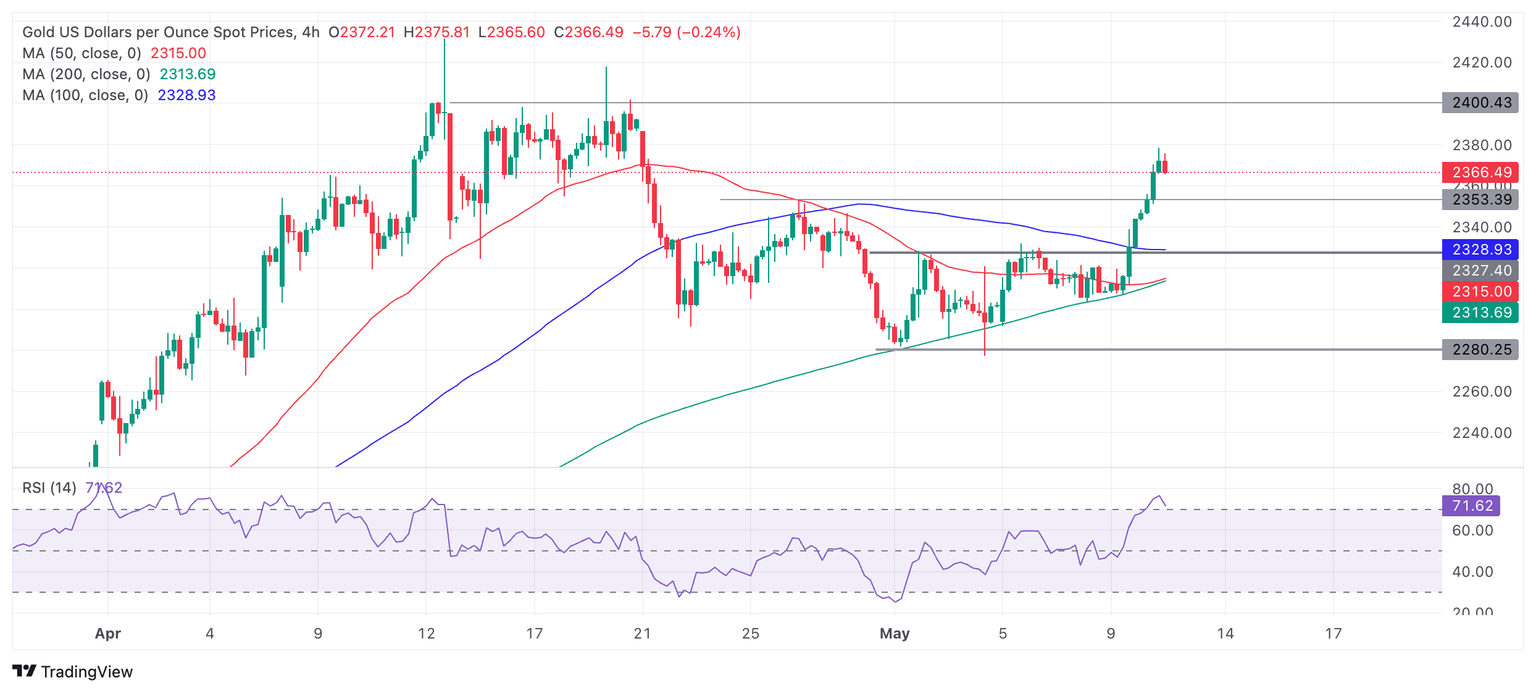Gold rallies on haven appeal and expectations of lower interest rates
- Gold rallies as investors turn to safety amid worsening geopolitical tensions.
- Weak US labor market data reignites speculation of early Fed rate cuts further driving Gold higher.
- Gold price enters a short-term uptrend with the bias favoring long-holders.

Gold price (XAU/USD) trades almost a percentage point higher in the $2,360s on Friday. The precious metal rises as increasing geopolitical tensions over Gaza solidify its safe-haven appeal.
The upside also results from concerns over the US labor market due to recent data, which have sparked speculation the Federal Reserve (Fed) may lower interest rates sooner than previously expected, increasing the attractiveness of the non-yielding precious metal.
Gold price rises on end of peace talks, US labor market concerns
Gold price rises due to its safe-haven appeal as peace talks between Hamas and Israel in Cairo break down and Israeli armor and military personnel amass around the city of Rafah, the last major urban center in Gaza not reduced to rubble.
The US, meanwhile, is withholding shipments of weapons and military aid to Israel after President Biden warned the country against mounting a full-scale attack on Rafah. Despite the warning, reports have come in of strikes to a mosque and several houses in the city, leading to the deaths of over a dozen people, including women and children, according to Reuters.
US Jobless Claims surprise to the upside
In the US, further evidence of a weakening labor market has reanimated expectations the Federal Reserve will need to cut interest rates sooner than previously thought.
US Initial Jobless Claims data for the week of May 3, released on Thursday, showed a higher-than-expected 231,000 rise when 210,000 had been expected from an upwardly revised 209,000 in the previous week.
This comes on the back of a Nonfarm Payrolls report that showed below-estimated readings for April in almost all key metrics measured.
The data suggests the US economy is struggling under the weight of the currently high interest rates environment and increases speculation the Fed may move to cut rates sooner than previously thought.
Commentary from Federal Reserve officials, however – most recently from Boston Fed President Susan Collins and Minneapolis Fed President Neel Kashkari – has leaned hawkish, with both arguing that inflationary pressures remain too high to consider reducing interest rates.
Major central banks mark a shift in stance
Globally most central banks are either cutting interest rates or signaling a willingness, leading to an environment in which interest rates appear to be peaking and declining – a positive for Gold.
On Wednesday, Sweden’s Riksbank cut interest rates for the first time since 2016, and the number of Bank of England (BoE) officials voting to cut rates on Thursday increased. At its March meeting, the Swiss National Bank (SNB) also opted to cut interest rates.
The European Central Bank (ECB) has all but guaranteed it will cut interest rates in June, and the Reserve Bank of Australia (RBA) accompanied its decision to hold interest rates steady at the last meeting, with dovish rhetoric.
Technical Analysis: Gold price breaks higher, beginning short-term uptrend
Gold price (XAU/USD) has broken through the ceiling of a mini-range and rallied sharply.
A reversal in the sequence of peaks and troughs on the 4-hour time frame chart now suggests the precious metal is in a short-term uptrend, which is biased to extend higher.
XAU/USD 4-hour Chart
The Relative Strength Index (RSI) momentum indicator is overbought, suggesting Gold may be overstretched and could be at risk of a pullback. A move down into neutral territory again would give a sell signal and indicate more clearly a correction. In the meantime, the advice for long-holders is not to add to their positions.
That said, the uptrend remains in progress and the price keeps pushing higher.
The next target to the upside for Gold is at around $2,400, roughly at the height of the April highs.
The bullish trend on both the medium and long-term charts (daily and weekly), overall add a supportive backdrop for Gold.
Risk sentiment FAQs
In the world of financial jargon the two widely used terms “risk-on” and “risk off'' refer to the level of risk that investors are willing to stomach during the period referenced. In a “risk-on” market, investors are optimistic about the future and more willing to buy risky assets. In a “risk-off” market investors start to ‘play it safe’ because they are worried about the future, and therefore buy less risky assets that are more certain of bringing a return, even if it is relatively modest.
Typically, during periods of “risk-on”, stock markets will rise, most commodities – except Gold – will also gain in value, since they benefit from a positive growth outlook. The currencies of nations that are heavy commodity exporters strengthen because of increased demand, and Cryptocurrencies rise. In a “risk-off” market, Bonds go up – especially major government Bonds – Gold shines, and safe-haven currencies such as the Japanese Yen, Swiss Franc and US Dollar all benefit.
The Australian Dollar (AUD), the Canadian Dollar (CAD), the New Zealand Dollar (NZD) and minor FX like the Ruble (RUB) and the South African Rand (ZAR), all tend to rise in markets that are “risk-on”. This is because the economies of these currencies are heavily reliant on commodity exports for growth, and commodities tend to rise in price during risk-on periods. This is because investors foresee greater demand for raw materials in the future due to heightened economic activity.
The major currencies that tend to rise during periods of “risk-off” are the US Dollar (USD), the Japanese Yen (JPY) and the Swiss Franc (CHF). The US Dollar, because it is the world’s reserve currency, and because in times of crisis investors buy US government debt, which is seen as safe because the largest economy in the world is unlikely to default. The Yen, from increased demand for Japanese government bonds, because a high proportion are held by domestic investors who are unlikely to dump them – even in a crisis. The Swiss Franc, because strict Swiss banking laws offer investors enhanced capital protection.
Author

Joaquin Monfort
FXStreet
Joaquin Monfort is a financial writer and analyst with over 10 years experience writing about financial markets and alt data. He holds a degree in Anthropology from London University and a Diploma in Technical analysis.


















